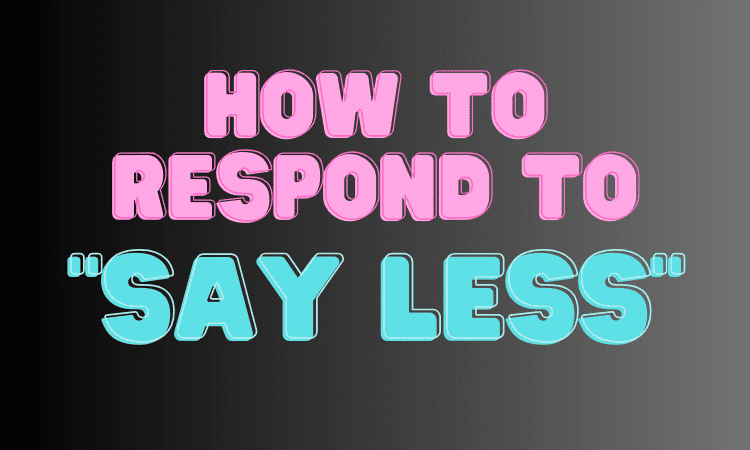The modern lingo is ever-evolving with catchy phrases and expressions that add a zing to our daily conversations. One such phrase that’s been catching the wave is “Say Less.” At a glance, it’s a simple two-word phrase, yet it carries a variety of meanings based on the situation.
This versatile phrase can mean “I understand,” show agreement, express excitement, or, at times, come off as impolite. Navigating the ‘Say Less’ wave requires a bit of finesse to ensure our responses are apt and keep the conversation flowing.
What are the Various Meanings of “Say Less”?
The phrase “Say Less” is an informal expression that can have various meanings depending on the context and tone in which it is used. Here are the primary interpretations:
- Agreement and Conciseness
In many cases, “Say Less” is used to express agreement with someone’s statement or to indicate that the point has been made effectively. It suggests that the speaker understands and acknowledges what has been said and that no further explanation or elaboration is necessary.- Example:
- Joe: “I aced the exam!”
- Anna: “Say Less! That’s awesome!”
- Example:
- Brevity and Clarity
It can also be used as a gentle way to encourage someone to be more concise and to the point. When someone says “Say Less” in this context, they are suggesting that the speaker should provide a more succinct and clear explanation.- Example:
- Joe: “Well, you see, there are various aspects to consider, and if you take into account the different variables, it becomes evident that…
- Anna: “Say Less, just give me the main points.”
- Example:
- Dismissiveness or Annoyance
In some cases, “Say Less” can be used to dismiss someone’s comments or to convey irritation or impatience. It essentially means “stop talking” and is used when someone finds the conversation uninteresting, irrelevant, or annoying.- Example:
- Joe: “I don’t understand why you’re upset about this.”
- Anna: “Say Less. It’s not worth explaining.”
- Example:
- Excitement or Approval
Surprisingly, “Say Less” can also be used to express excitement or approval. In this context, it signifies that the news or information shared is so good that further words are unnecessary.- Example:
- Joe: “We just won tickets to the concert!”
- Anna: “Say Less! That’s incredible!”
- Example:
The exact meaning of “Say Less” in a given situation depends on the speaker’s tone, the context of the conversation, and the relationship between the people involved. It’s important to consider these factors to interpret the phrase correctly.
How to Respond to “Say Less” based on the Different Interpretations?
1. Agreement and Conciseness:
- When someone uses “Say Less” to indicate agreement or acknowledgment, you can respond positively or simply move on with the conversation.
- Response: “I appreciate that, thanks!”
- Response: “Got it, thanks for understanding.”
- Response: “Absolutely!”
- Response: “I’m with you.”
- Response: “No need to say more, I’m on board.”
2. Brevity and Clarity:
- If “Say Less” is used to encourage brevity and clarity, acknowledge the request and proceed with a more concise explanation.
- Response: “Sure, let me summarize the key points.”
- Response: “Of course, in a nutshell, [concise summary].”
- Response: “Oops, got it, I’ll be brief.”
- Response: “My bad, I tend to ramble sometimes.”
- Response: “I’ll keep it short.”
- Response: “Sorry, I tend to overexplain sometimes.
- Response: “I’ll keep it concise next time.
- Response: “My apologies, too much detail.
3. Dismissiveness or Annoyance:
- When “Say Less” is used dismissively, it’s essential to consider the context and the relationship with the person. You can respond by seeking clarification or changing the topic if the situation allows.
- Response: “I sense some frustration. Can we talk about this later when you’re ready?”
- Response: “Okay, let’s discuss something else then.”
- Response: “I get it; I’ll stop.”
- Response: “Sorry if I’m bothering you. I’ll be quiet now.”
- Response: “I’ll take the hint and let you be.”
- Response: “My apologies; I’ll give you some space.”
4. Excitement or Approval:
- When “Say Less” is used to express enthusiasm or approval, acknowledge the excitement and reciprocate the positivity.
- Response: “Wow, that’s amazing news! I’m thrilled!”
- Response: “Say Less? I can’t help but be excited too!
- Response: “Wow, that’s incredible!”
- Response: “Seriously? That’s amazing!”
- Response: “No way, that’s unbelievable!”
In each case, your response should align with the intended meaning and tone of “Say Less” in the conversation, while also considering the dynamics between you and the other person.
Conclusion
The phrase “Say Less” is a multifaceted expression that reflects the richness of human communication. It can convey agreement, the need for brevity, dismissal, or excitement, depending on the context and the speaker’s intent. Understanding these interpretations is essential for effective and respectful communication.
When someone says “Say Less,” it’s crucial to respond appropriately, taking into account the context and your relationship with the person. Responding with empathy and awareness can help maintain positive and productive conversations. Whether you acknowledge, summarize, seek clarity, or change the topic, your response should align with the situation’s dynamics.
Ultimately, communication is a dance between individuals, and the phrase “Say Less” serves as a unique step in that dance. By interpreting it accurately and responding with consideration, we can navigate conversations with finesse, ensuring that our interactions are both meaningful and harmonious.
So, remember, the next time you hear “Say Less,” take a moment to appreciate the nuances and respond accordingly to enhance your communication skills and build stronger connections with others.





Leave a Reply